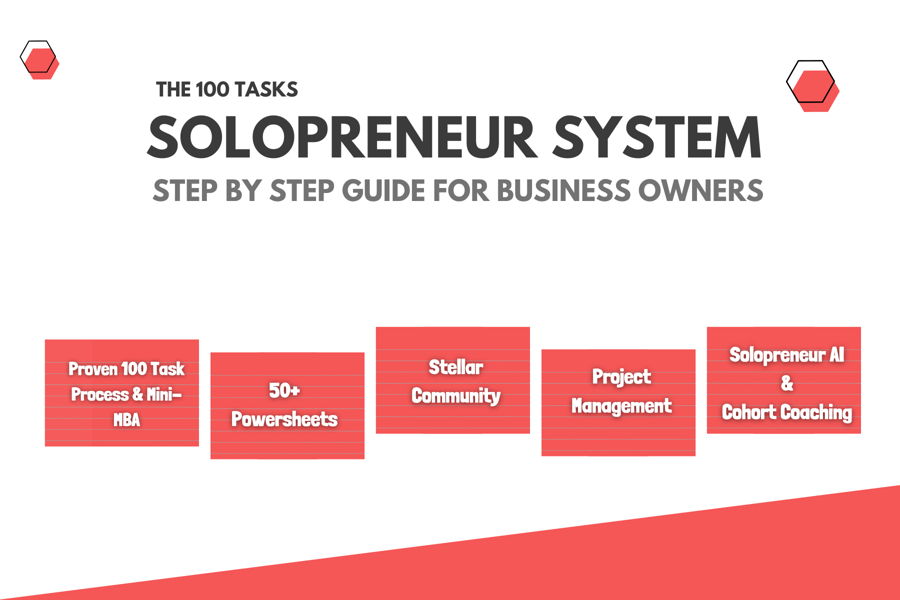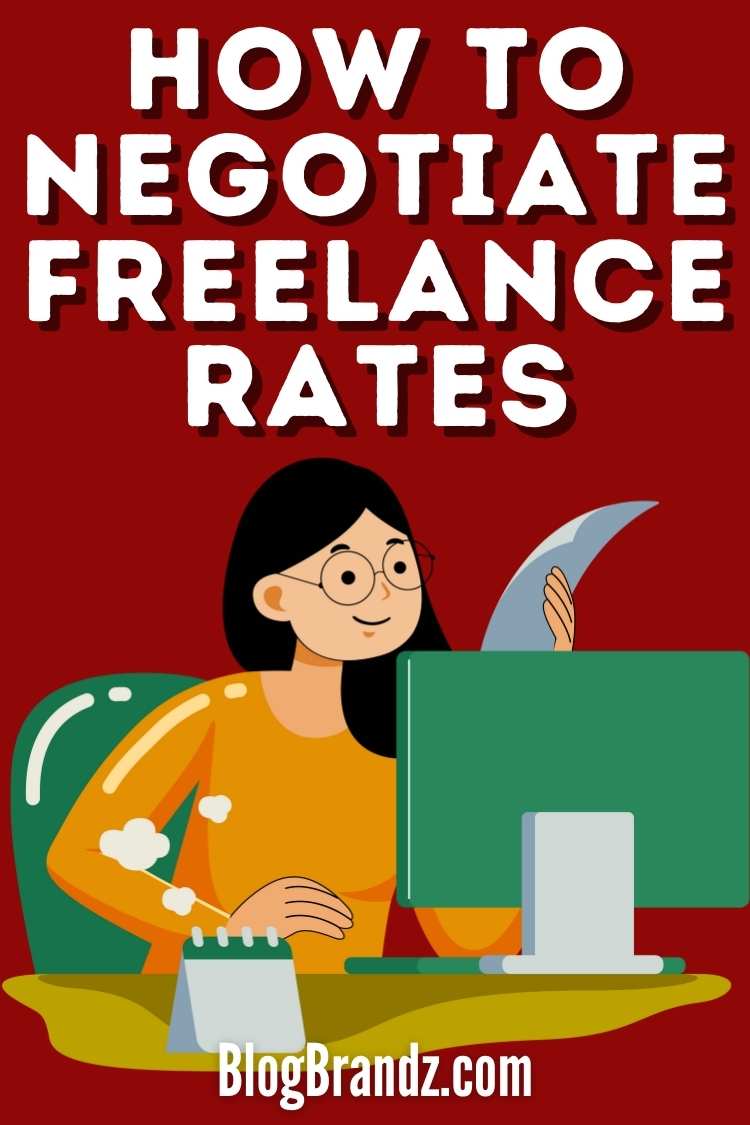Learn how to negotiate freelance rates effectively by selling value instead of competing on price to maximize your earnings.
Negotiating freelance rates can often feel like walking a tightrope, balancing the need for fair compensation with the desire to win over clients. However, the key to successful negotiation lies not in haggling over prices but in demonstrating the unique value you bring to the table.
When you shift the conversation from cost to value, you position yourself as a premium service provider and build stronger, more profitable relationships with your clients.
This article explores practical strategies to help you negotiate freelance rates effectively, emphasizing the importance of selling your value rather than competing on price.
You’ll discover how to earn more money as a freelancer with strategic planning, skill enhancement, and effective marketing to maximize your income.
Whether you’re a seasoned freelancer or just starting, these insights will empower you to secure better deals and establish a more sustainable, rewarding career.
Contents
What Factors Do Freelance Rates Depend On?
Freelance rates can vary significantly based on a variety of factors. Here are some key considerations for setting competitive and fair pricing:
#1. Experience & Expertise
Freelancers with more experience or specialized skills typically command higher rates due to their proven track record and advanced capabilities.
Their expertise allows them to deliver superior quality work efficiently, often justifying a premium price. Clients are generally willing to pay more for the assurance of reliable and professional service.
#2. Industry Standards
Freelance rates vary significantly across industries. For instance, graphic designers may charge differently than writers or developers due to differences in skill sets, project requirements, and market demand.
Each industry has its standards and expectations, influencing how freelancers set their rates to remain competitive and fair within their specific field.
#3. Location
The cost of living in a freelancer’s location can significantly impact their rates. Freelancers in high-cost areas often charge more to cover their living expenses. Conversely, those in regions with a lower cost of living might offer more competitive rates, reflecting the financial demands of their geographical location.
For example, freelance rates in South Africa tend to be higher than in many other African countries, including neighboring countries. This is partly due to the country’s relatively higher cost of living and a stronger economy.
Freelancing rates in India are known to be more competitive, often lower compared to Western countries and some other regions. This is influenced by factors such as a larger pool of freelancers, varying cost of living across different cities, and the global demand for outsourcing services.
#4. Project Complexity & Scope
More complex or larger projects typically command higher fees due to the increased time, effort, and expertise required.
These projects often involve detailed planning, advanced skills, and extended work periods, justifying a higher rate to compensate for the added complexity and scope. Clients expect to pay more for comprehensive and intricate work.
#5. Turnaround Time
Projects requiring quick turnaround times often come with a premium charge. Freelancers may need to prioritize these projects over others or work extended hours to meet tight deadlines.
This additional effort and potential disruption to their schedule justify higher rates for expedited work.
#6. Client Type & Budget
Rates can vary based on the client’s budget and the perceived value of the work. Corporate clients typically have higher budgets and may pay more for premium services.
In contrast, small businesses or individuals often have tighter budgets, which can influence the rate a freelancer charges.
#7. Market Demand & Conditions
High demand for certain skills can drive up freelance rates. When specialized skills are in short supply but in high demand, freelancers can charge more for their services, especially if clients recognize your expertise and reliability.
This market dynamic ensures that professionals with sought-after expertise receive compensation that reflects their value and scarcity. Understanding current market rates and economic trends allows you to negotiate your freelancing rates based on industry standards and client budgets.
#8. Freelancer’s Brand & Reputation
Freelancers with a strong portfolio and solid reputation can often command higher rates. A solid reputation within your industry, backed by references or endorsements, enhances your negotiating power.
A well-established freelancer brand with a strong portfolio showcasing successful projects and client testimonials builds credibility and supports your value proposition. It demonstrates reliability and quality, making clients more willing to pay a premium for proven expertise and dependable service.
#9. Length of Engagement
Long-term projects often provide stability, allowing freelancers to negotiate lower rates due to the guaranteed duration of work. Offering discounts or incentives for long-term contracts can secure steady work and income.
In contrast, short-term projects with intense deadlines or high complexity may justify higher rates to compensate for the concentrated effort and shorter engagement period.
#10. Additional Costs
Freelancers often factor in additional costs such as specialized software, equipment, or other resources necessary to complete a project.
These expenses can influence their rates, ensuring they cover operational costs and deliver high-quality results without incurring financial losses.
#11. Certifications & Education
Additional qualifications or certifications can justify higher freelance rates. Clients value specialized knowledge and skills backed by formal education or industry certifications, which enhance credibility and assurance of quality.
Freelancers with advanced qualifications can leverage this expertise to command premium rates for their services.
#12. Negotiation Skills
Effective negotiation skills are crucial in setting freelance rates. Freelancers who can confidently articulate their value, understand client needs and negotiate terms effectively are more likely to secure fair compensation.
This ability to negotiate can influence how rates are set and perceived, ensuring both parties achieve a mutually beneficial agreement.
By leveraging these factors strategically, freelancers can negotiate rates that reflect their skills, experience, and the value they bring to clients, ensuring fair compensation and sustainable business growth.
How To Negotiate Freelance Rates & Sell Value Instead Of Price
Negotiating freelance rates by selling value instead of price is a strategic move to reflect your growing expertise, the value you provide, and market demand.
It allows freelancers and solopreneurs to differentiate themselves and justify higher rates. Here are some ways to earn more money as a freelancer by negotiating an increase in your freelance rates:
#1. Know Your Worth
Researching industry standards is crucial to accurately gauge the market rates that align with your skills and experience. Understanding these benchmarks helps you confidently set rates that reflect your expertise and market value.
For example, if you’re a graphic designer, compare rates on platforms like Glassdoor, Payscale, or industry-specific forums to understand where your pricing stands relative to others in your field.
#2. Build a Strong Portfolio
Building a compelling portfolio is about curating and showcasing your best work to demonstrate your expertise and track record of success. Highlight projects that showcase your skills and have a tangible positive impact on your clients or projects.
For instance, if you’re a social media manager, include case studies where you significantly increased engagement and conversions for a client by implementing a strategic campaign.
Use metrics such as increased follower count, higher click-through rates, or improved sales figures to vividly illustrate the outcomes of your work.
A robust portfolio rich with such examples justifies higher rates and positions you as a valuable asset capable of delivering measurable results.
Resources:
#3. Invest in Branding
Investing in branding is essential to cultivate a strong personal or business identity that reflects professionalism and quality. By developing high-quality branding and marketing materials, you enhance the perceived value of your services.
For example, a polished logo, consistent visual identity across platforms, and a professional website can significantly elevate your brand’s credibility. These elements attract potential clients and justify higher rates by signaling reliability and expertise in delivering top-notch services.
You can boost your personal brand and online visibility by publishing information products like blogs, eBooks, online courses, or print-on-demand products related to your freelance work. This will also help you create passive income streams to supplement your freelance income.
Resources:
- Personal Branding for Freelancers: How to Build a Freelancer Brand
- 8 Reasons to Incorporate a Business as a Freelancer
- How to Start Creating an Online Presence for Your Business
#4. Assess Your Current Value
Assessing your current value involves reflecting on your skills, experience, and client outcomes. For instance, if you’re a digital marketer, you might determine your ability to drive a 30 percent increase in website traffic and a 20 percent rise in conversion rates for a recent client.
Gathering testimonials highlighting how your strategies significantly boosted their online presence and sales further solidifies your value proposition to future clients.
#5. Update Your Skills & Innovate
To update your skills and stay current with industry trends, invest in professional development through courses, certifications, or workshops to stay ahead.
Focus on a specific area where you have expertise. Specialization can allow you to charge higher rates due to the unique value you offer.
For example, as a software developer, mastering new programming languages or frameworks can enhance your ability to offer cutting-edge solutions.
Clients value innovative approaches that solve modern challenges, allowing you to command premium prices for your expertise and forward-thinking solutions.
Resources:
#6. Communicate your USP
To communicate your Unique Selling Proposition (USP), articulate the specific value you offer and the benefits clients can expect from working with you. Highlight your experience, unique skills, and past successes that differentiate you from competitors.
For instance, if you’re a marketing consultant specializing in small businesses, emphasize your personalized strategies that consistently drive significant ROI. Use client testimonials, case studies, and a well-curated portfolio to build credibility and demonstrate tangible results.
Showcase specific examples of how your expertise positively impacted others, such as increasing sales by 40 percent or improving brand visibility through strategic campaigns.
During business proposals and client meetings, focus on illustrating how your contributions directly contribute to their business growth and success. This approach solidifies your USP and positions you as a valuable partner capable of delivering measurable outcomes.
Resources:
- How To Write a Unique Selling Proposition (USP)
- Pitching Yourself: The Complete Course to Help You Pitch
#7. Understand Client Needs & Budget
To understand client needs and budgets, begin by thoroughly understanding their pain points, goals, and challenges. Then tailor your services to address these specific needs, emphasizing how your solutions can effectively resolve their issues rather than just completing tasks.
Early in the conversation, inquire about the client’s budget. This proactive approach allows you to align your proposal with their financial constraints while ensuring your rate reflects the value you provide.
By demonstrating a clear understanding of their situation and offering tailored solutions that meet both their needs and budget, you enhance your chances of securing the project at a fair and satisfactory rate.
#8. Build Strong Relationships
Building strong relationships with clients is pivotal in freelancing. Regular communication, reliability, and genuine interest in their success foster trust and client loyalty.
When clients feel valued and supported, they are more inclined to perceive your services as valuable, justifying higher rates.
This trust-based approach not only enhances client satisfaction but also positions you as a dependable partner invested in their long-term success, making them more willing to invest in your expertise.
Resources:
#9. Educate Your Clients
Educating your clients about the full value of your services is crucial for setting appropriate rates and fostering mutual understanding. Explain the intricacies of your work, the specialized expertise you bring, and the potential risks associated with cheaper alternatives.
For example, as a cybersecurity consultant, clarify the comprehensive protection measures you implement to safeguard their data compared to basic security solutions.
By transparently illustrating the value and benefits of investing in your premium services, you empower clients to make informed decisions based on quality and long-term value rather than solely on cost.
#10. Test with New Clients First
Implementing rate increases with new clients first is a strategic approach to testing and refining your pricing strategy. By introducing higher rates to new clients, you can gauge market response and assess the perceived value of your services without immediately affecting existing client relationships.
This method allows you to fine-tune your approach, justify the new rates based on your value proposition, and gradually transition existing clients to the updated pricing structure once you are confident in its effectiveness.
Give existing clients ample notice before raising your rates, ideally 30 to 60 days. Explain the reasons for the rate increase, focusing on the added value and improved services you offer. It also ensures a smoother transition while maintaining trust and satisfaction among your client base.
#11. Offer Tailored Packages & Retainers
Offering tailored packages and retainers effectively justifies and implements rate increases. Provide tiered pricing options, allowing clients to choose services that fit their budget and needs.
For example, a marketing consultant might offer basic, standard, and premium packages, ranging from essential services to comprehensive strategies. Creating structured service packages or retainer agreements can help showcase additional value and justify higher rates.
These packages offer clarity and transparency, highlighting specific benefits and outcomes of each service tier. Tailored solutions addressing unique client challenges and goals enhance perceived value, making your services appear more valuable and personalized than generic offerings.
This approach accommodates varying client budgets and positions your rate increase as a strategic adjustment based on the increased value and customized solutions you provide, reinforcing fairness and choice while emphasizing the benefits of investing in your expertise.
Resources:
#12. Set Clear Expectations
To set clear expectations, foster client trust, and justify your rates, outline what is included in your rates by defining the scope, deliverables, and timeline of your projects.
For example, if you’re a web developer, specify the number of web pages, functionalities, and maintenance services covered under your rate. When clients have a comprehensive understanding of what they will receive and how it will benefit them, they are more likely to appreciate the value of your services.
Explain any potential additional costs or expenses upfront, such as software licenses or additional revisions, to avoid surprises during the project. This transparency builds confidence and reinforces your professionalism, ensuring a positive client experience while substantiating the rationale behind your rates.
#13. Focus on Outcomes
Focusing on outcomes shifts the conversation from tasks to results, emphasizing the value of your services over hourly rates. Instead of pricing based solely on time, establish fees that reflect the anticipated impact on the client’s business.
For instance, as a marketing consultant, propose a project fee based on the expected increase in sales or market share resulting from your campaign.
Highlighting the benefits and impact of your work is key. Emphasize how your services can lead to increased revenue, improved operational efficiency, or a stronger brand presence.
By aligning your pricing with these outcomes, you demonstrate a clear understanding of your client’s goals and reinforce the tangible value of investing in your expertise.
This approach not only positions you as a strategic partner focused on delivering measurable results but also justifies your rates based on the substantial business benefits your services provide.
Resources:
#14. Add Value-Added Services
Adding value-added services is a strategic way to justify rate increases while enhancing the overall appeal of your offerings. Introduce supplementary services that complement your core services and provide additional value without significantly raising costs.
Providing additional services or benefits beyond basic deliverables can justify higher rates. For example, as a digital marketing consultant, you could offer detailed analytics reports, strategic advisory sessions, or follow-up consultations to optimize campaign performance.
By bundling these value-added services with your core offerings, you create a more comprehensive and attractive package for clients. This approach helps them perceive the rate increase as a part of a broader enhancement in service rather than just a price hike.
Emphasize how these additional services can further support their goals and maximize the impact of your primary services, reinforcing the value proposition and justifying the adjusted rates based on the expanded benefits and enhanced client experience you provide.
#15. Be Confident
Approaching rate discussions with confidence is essential to assert your worth and adhere to market standards. Establish a minimum rate that reflects your value and expertise, ensuring you are compensated fairly for your skills.
Believe in your worth and be prepared to stand firm on your rates during negotiations. If a client cannot meet your minimum rate, be willing to respectfully decline the opportunity and seek clients who recognize and value your contributions appropriately.
This confident approach not only safeguards your financial well-being but also reinforces your professionalism and commitment to maintaining fair and equitable business practices.
Resources:
#15. Negotiate Based on Project Scope
Negotiating based on project scope involves breaking down the project into manageable phases or milestones. This approach makes it easier to discuss and negotiate rates for each specific part of the project, aligning pricing with the complexity and deliverables of each phase.
For example, as a web developer, you might propose separate rates for initial design concepts, development stages, testing, and final deployment. By outlining clear milestones and associated costs, you provide transparency and clarity to the client, ensuring they understand the value they receive at each stage.
This structured approach also allows flexibility in adjusting rates based on the intricacy or additional requirements of individual project phases, facilitating constructive discussions that benefit both parties.
Ultimately, negotiating based on project scope helps maintain fair pricing while ensuring your services meet client expectations and project goals.
#16. Consider Non-Monetary Benefits
When negotiating rates, consider non-monetary benefits that clients may offer, such as long-term contracts, exposure, or valuable connections. These benefits can sometimes outweigh monetary compensation in terms of long-term value and career growth.
For example, a long-term contract can provide stability and predictability in income, while exposure through a high-profile project can enhance your reputation and lead to future opportunities.
Evaluate these non-monetary benefits alongside financial compensation during negotiations. Assess how they align with your career goals, professional development, and overall business strategy.
By weighing these factors, you can make informed decisions that optimize both immediate and future benefits, ensuring a balanced and mutually beneficial agreement with your clients.
#17. Practice Active Listening
Practice active listening to understand the client’s needs and concerns effectively. By attentively listening to their requirements and pain points, you gain valuable insights into their challenges and goals.
Tailor your proposal accordingly, focusing on how your services can directly address their specific needs and provide solutions. For instance, if you’re a graphic designer pitching to a client who needs to refresh their brand image, actively listen to their branding challenges and desired outcomes.
Then, customize your proposal to showcase how your design solutions can enhance their brand identity, improve customer perception, and achieve their marketing objectives.
Demonstrating a clear understanding of their concerns and articulating how your expertise can resolve them not only strengthens your proposal but also builds trust and credibility with the client.
This approach ensures that your services are perceived as valuable and relevant to their business objectives, facilitating a more productive and successful negotiation process.
Resources:
#18. Use Anchoring Techniques
Using anchoring techniques in negotiation involves starting with a higher rate than what you’re willing to accept initially.
This strategy sets a higher anchor point in the client’s mind, influencing their perception of the value of your services. Even if the client negotiates down from your initial rate, you are more likely to reach a final agreement that aligns with your expectations.
For example, if you believe your services are worth $100 per hour, you might initially propose $120 per hour to anchor the negotiation higher. This gives you room to negotiate while still aiming to secure a rate closer to your desired $100 per hour.
However, it’s essential to approach anchoring with flexibility and a clear understanding of market rates and client expectations. Effective negotiation involves finding a balance between asserting your value and accommodating the client’s budget constraints or preferences.
This strategic approach can help maximize your earnings while maintaining a collaborative and positive client relationship.
Resources:
#19. Offer Discounts for Long-Term Contracts
Offering a discount for long-term contracts or retainer agreements can be a strategic approach to securing steady work and income.
By providing a small discount, you demonstrate flexibility and commitment to the client’s long-term needs, potentially incentivizing them to commit to a more extended engagement.
For instance, if your standard rate is $100 per hour, you might offer a discounted rate of $95 per hour for a client who signs a six-month retainer agreement.
This slight reduction can be perceived as a value-added benefit for the client while ensuring a stable income stream for you over the contract period. When considering this approach, it’s important to weigh the benefits of steady work against the potential revenue impact of the discount.
Ensure that the discounted rate still aligns with your financial goals and reflects the value you provide. This strategy can strengthen client relationships, foster loyalty, and create a mutually beneficial arrangement for both parties involved.
#20. Be Prepared to Walk Away
If a client is unwilling to meet your rate despite your efforts to justify it, it’s important to consider declining the offer respectfully.
Accepting a rate that undervalues your work can set a precedent that may impact future negotiations and diminish your perceived worth in the industry. By walking away from an agreement that does not meet your financial expectations, you uphold the value of your skills and expertise.
This decision reinforces your professionalism and commitment to fair compensation, ensuring that your rates align with market standards and the quality of service you provide.
While it may feel challenging at the moment, standing firm on your rates demonstrates integrity and positions you for opportunities that better appreciate your contributions.
#21. Follow Up with Clients
Following up after a client initially rejects your rate can be a strategic move, especially if they struggle to find a suitable freelancer at a lower rate. By maintaining communication and demonstrating continued interest in their project, you position yourself as a reliable and committed option.
For example, if a client decides to go with a lower-priced freelancer but encounters issues with quality or reliability, reaching out politely to check on their progress and offer your services again can be beneficial. Highlight any unique qualifications or recent successes that may strengthen your proposal.
This approach shows persistence and a genuine desire to help solve their problem, potentially prompting them to reconsider your initial rate. However, it’s essential to strike a balance between assertiveness and respect for their decision-making process.
This way, you can maintain a positive professional relationship while remaining open to future opportunities that may align better with your rate expectations.
Resources:
#22. Regularly Review & Adjust Rates
Regularly reviewing and adjusting your rates is crucial to ensure you are charging competitively and reflecting the value of your services. Make it a consistent part of your business strategy to periodically assess market conditions, expertise level, and the overall demand for your skills.
For example, you might review your rates annually or biannually to stay aligned with industry standards and inflation. Consider factors such as changes in cost of living, improved skills or qualifications, and feedback from clients regarding the value they perceive in your services.
By making rate adjustments based on informed analysis rather than reacting ad hoc to individual negotiations, you maintain consistency and fairness in your pricing.
This proactive approach helps you stay competitive and ensures you’re adequately compensated for your expertise and the value you deliver to clients over time.
It reinforces your professionalism and commitment to sustaining a viable freelance business that meets both your financial goals and client expectations effectively.
These strategies to help you negotiate freelance rates more effectively will help freelancers and solopreneurs sell value, making their services more attractive to clients willing to pay for quality and results.
By increasing your profits, you can ensure that you’re fairly compensated for your work.
Workplace Negotiation Courses & Tutorials
Explore these negotiation courses and tutorials to enhance your skills in effectively navigating business discussions with clients and colleagues.
#1. Successful Negotiation Strategies & Skills
Negotiation plays a pivotal role in business success, as profitable contracts are the lifeblood of any enterprise. Additionally, within a company, honing negotiation skills can pave the way for career progression.
In this course on Successful Negotiation: Essential Strategies & Skills from the University of Michigan, you’ll learn how to strategically plan your negotiation approach, setting the stage for productive discussions.
Employ key tactics to navigate the negotiation process effectively, ensuring mutually beneficial outcomes. Finalize the negotiation by creating a binding contract that encapsulates agreed-upon terms and conditions.
Assess the results and implications of the negotiation, analyzing its impact on the overall business strategy. By mastering these steps, you can enhance your negotiation prowess and drive success both within your organization and the broader business landscape.
Click here to preview this negotiation course
#2. Negotiation MasterClass by Chris Voss
Explore the art of workplace negotiation in former FBI hostage negotiator Chris Voss’s MasterClass, where you’ll learn 12 proven tactics for workplace success. This course is designed to empower you with the skills needed to assert your voice and achieve favorable outcomes.
You’ll gain practical skills to navigate high-pressure situations, build trust, and effectively communicate in meetings and daily interactions, from mastering the art of active listening to honing your persuasive communication skills.
Voss guides you through essential negotiation tactics designed to sharpen your negotiation acumen and empower you to navigate various workplace scenarios with finesse.
Chris Voss’ MasterClass prepares you to excel in negotiations, enhancing your professional influence and fostering collaborative environments where your voice is heard and respected.
Click here to preview Chris Voss’ MasterClass
Freelance Rate Increase Notice Example
Learn how to ask for a rate increase as a freelancer with this example of a freelance rate increase notice to inform your clients of the upcoming changes in your pricing structure.
Subject: Upcoming Changes to Service Rates
Dear [Client’s Name],
I hope this message finds you well. I wanted to inform you about an upcoming change to my service rates. Over the past [period], I have continued to invest in expanding my skills and enhancing the quality of services I provide. This has allowed me to deliver even greater value and results for clients like you.
To reflect these improvements and align with industry standards, I will be adjusting my rates effective [date]. My new rate will be [$X/hour or project].
I am committed to ensuring this transition is smooth and that you continue to receive the high level of service you expect. If you have any questions or wish to discuss how this change might affect your projects, please feel free to reach out.
Thank you for your understanding and continued partnership.
Best regards,
[Your Name]
By strategically increasing your rates and effectively communicating the reasons behind the change, you can maintain client relationships while ensuring your compensation reflects your expertise and value.
Ballpark Freelance Rates for Services
Freelance rates vary widely based on experience, location, and project complexity. Here are some ballpark figures for various freelance roles, considering a range from entry-level to experienced professionals:
#1. Graphic Design Freelance Rates
- Entry-level: $25 – $50 per hour
- Mid-level: $50 – $100 per hour
- Senior-level: $100 – $150+ per hour
#2. SEO Freelance Rates
- Entry-level: $30 – $50 per hour
- Mid-level: $50 – $100 per hour
- Senior-level: $100 – $200+ per hour
#3. SEM Freelance Rates
- Entry-level: $30 – $50 per hour
- Mid-level: $50 – $100 per hour
- Senior-level: $100 – $150+ per hour
#4. Social Media Freelance Rates
- Entry-level: $20 – $40 per hour
- Mid-level: $40 – $75 per hour
- Senior-level: $75 – $150+ per hour
#5. Copywriter Freelance Rates
- Entry-level: $20 – $50 per hour
- Mid-level: $50 – $100 per hour
- Senior-level: $100 – $150+ per hour
#6. Video Editor Freelance Rates
- Entry-level: $20 – $50 per hour
- Mid-level: $50 – $100 per hour
- Senior-level: $100 – $200+ per hour
#7. Bookkeeping Freelance Rates
- Entry-level: $20 – $40 per hour
- Mid-level: $40 – $75 per hour
- Senior-level: $75 – $100+ per hour
#8. Project Manager Freelance Rates
- Entry-level: $30 – $50 per hour
- Mid-level: $50 – $100 per hour
- Senior-level: $100 – $150+ per hour
#9. Digital Marketing Freelance Rates
- Entry-level: $30 – $50 per hour
- Mid-level: $50 – $100 per hour
- Senior-level: $100 – $150+ per hour
#10. Email Marketing Freelance Rates
- Entry-level: $25 – $50 per hour
- Mid-level: $50 – $100 per hour
- Senior-level: $100 – $150+ per hour
#11. Salesforce Freelance Rates
- Entry-level: $50 – $75 per hour
- Mid-level: $75 – $125 per hour
- Senior-level: $125 – $250+ per hour
These figures provide a general guideline, and freelance rates can vary significantly based on specific circumstances, including the freelancer’s unique skills, the nature of the project, and the client’s budget. Always tailor your freelancing rates to reflect your experience and the value you deliver.
The 100 Tasks Solopreneur System is a proven step-by-step process, all-in-one guide, framework, toolkit, and community to help solopreneurs and freelancers launch, optimize, and automate their businesses 3 to 5 times faster.
Click here to get the 100 Tasks Solopreneur Course
Freelancing Tools & Tutorials
- Fiverr’s Workspace Tool for Freelancers
- How to Build a Successful Freelancer Business
- 10 Tips to Safeguard Your Privacy as a Freelancer
- How To Make Money as a Creative Freelancer
- 10 Ways To Get More Freelance Writing Gigs
- Personal Finance for Freelancers & Solopreneurs
- Complete Guide to Freelancing: Zero to Mastery
- The Ultimate Guide to Freelancing For Creatives
- ChatGPT: The Secret to Upwork & Fiverr Freelancing Success
- Upwork Proposal Mastery: The Complete Guide to Proposal Writing
- Beyond Upwork: How to Find Freelance Clients Outside Upwork
- Marketing For Freelancers: Get Clients With No Budget
- Pitching Yourself: The Complete Course to Help You Pitch
© 2024, Priya Florence Shah. All rights reserved.
Priya Florence Shah is a bestselling author and an award-winning blogger. Check out her book on emotional self-care for women. Priya writes short stories and poetry and chills with her two-legged and four-legged kids in her spare time.
Discover more from Business & Branding Tips
Subscribe to get the latest posts sent to your email.

























